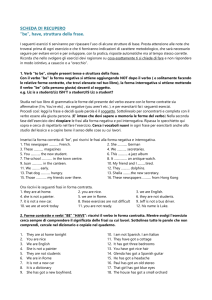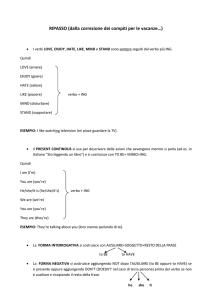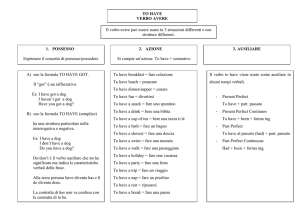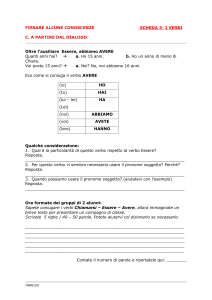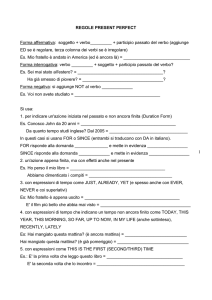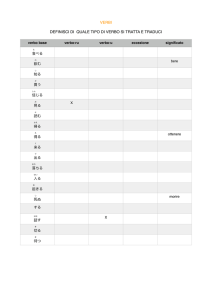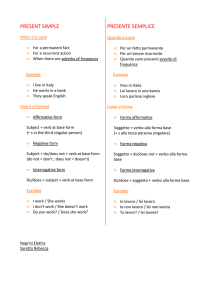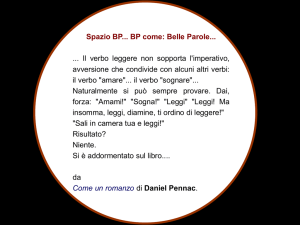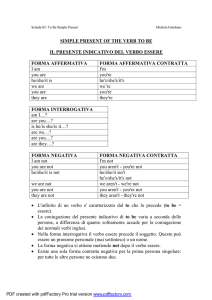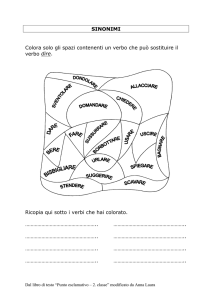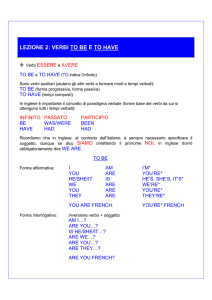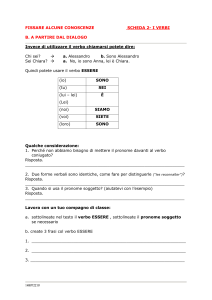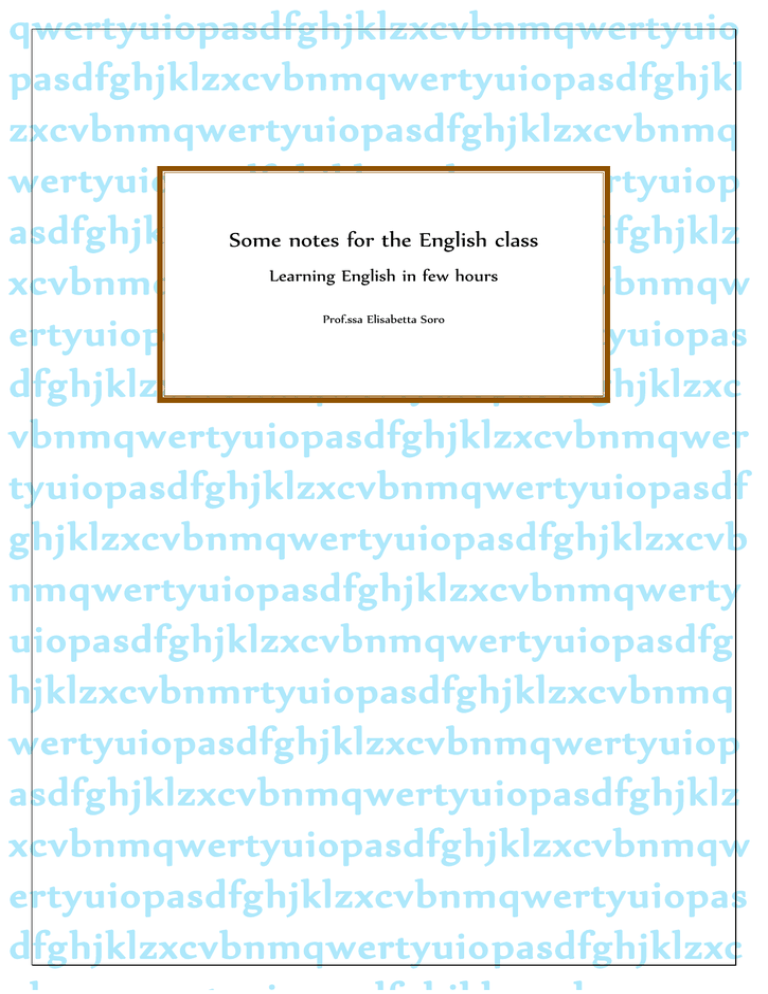
qwertyuiopasdfghjklzxcvbnmqwertyuio
pasdfghjklzxcvbnmqwertyuiopasdfghjkl
zxcvbnmqwertyuiopasdfghjklzxcvbnmq
wertyuiopasdfghjklzxcvbnmqwertyuiop
asdfghjklzxcvbnmqwertyuiopasdfghjklz
Some notes for the English class
Learning English in few hours
xcvbnmqwertyuiopasdfghjklzxcvbnmqw
ertyuiopasdfghjklzxcvbnmqwertyuiopas
dfghjklzxcvbnmqwertyuiopasdfghjklzxc
vbnmqwertyuiopasdfghjklzxcvbnmqwer
tyuiopasdfghjklzxcvbnmqwertyuiopasdf
ghjklzxcvbnmqwertyuiopasdfghjklzxcvb
nmqwertyuiopasdfghjklzxcvbnmqwerty
uiopasdfghjklzxcvbnmqwertyuiopasdfg
hjklzxcvbnmrtyuiopasdfghjklzxcvbnmq
wertyuiopasdfghjklzxcvbnmqwertyuiop
asdfghjklzxcvbnmqwertyuiopasdfghjklz
xcvbnmqwertyuiopasdfghjklzxcvbnmqw
ertyuiopasdfghjklzxcvbnmqwertyuiopas
dfghjklzxcvbnmqwertyuiopasdfghjklzxc
Prof.ssa Elisabetta Soro
Livello PRINCIPIANTI ASSOLUTI
Subject personal pronouns (pronomi personali soggetto)
I pronomi personali soggetto, come dice già il nome (pro-nome significa “al posto del nome”) sostituiscono il soggetto
perché questo non venga inutilmente ripetuto. Posso dire:
Mario va ogni giorno a scuola. Lui studia matematica e inglese con piacere.
Nell’esempio sopra Mario è stato sostituito la seconda volta con il pronome personale “lui.”
I
YOU
HE
SHE
IT
WE
YOU
THEY
IO
TU
LUI
LEI
ESSO/A
NOI
VOI
LORO
NOTA:
Il pronome I in inglese non esiste nella forma minuscola. È sempre scritto in “capital letter” (lettera maiuscola).
Il pronome you vuol dire sia tu che voi. Si pronuncia e si scrive nello stesso modo. Si capisce quale dei due si sta
usando dal contesto generale.
(rivolto a una persona) You are really smart (sei davvero in gamba).
(rivolto a un gruppo di persone) You are in room 13 (siete nella stanza 13).
La terza persona singolare è composta da tre voci: he (maschile), she (femminile) e it (usato per animali o cose).
WARNING: In inglese non esiste il soggetto sottinteso, perciò il pronome o il nome proprio (Mario, Steven…) vanno
sempre espressi.
Livello PRINCIPIANTI ASSOLUTI
To be (verbo essere)
Forma affermativa
Traduzione
Forma contratta
Forma negativa
I am
Io sono
I’m
I am not
You are
Tu sei
You’re
You are not
He is
Egli è
He’s
He is not
Is he?
She is
Ella è
She’s
She is not
Is she?
It is
Esso/a è
It’s
It is not
We are
Noi siamo
We’re
We are not
Are we?
You are
Voi siete
You’re
You are not
Are you?
They are
Essi sono
They’re
They are not
Are they?
La forma contratta si usa
negli scritti informali e
nel parlato
La forma negativa può
anche essere abbreviata in
due modi (vedi sotto)*
La forma estesa si
utilizza negli scritti
formali
Forma
interrogativa
Am I?
Are you?
Is it?
La forma contratta della negativa esiste in due versioni per tutte le persone eccetto la prima singolare. Il verbo può
essere abbreviato insieme al pronome oppure insieme alla particella not.
I’m not
I amn’t
You’re not
You aren’t
He’s not
He isn’t
She’s not
She isn’t
It’s not
It isn’t
We’re not
We aren’t
You’re not
You aren’t
They’re not
They aren’t
Livello PRINCIPIANTI ASSOLUTI
To have got* (verbo avere)
Forma affermativa
Traduzione
Forma contratta
Forma negativa
Forma interrogativa
I have got
Io ho
I’ve got
I have not got
Have I got?
You have got
Tu hai
You’ve got
You have not got
He has got
Egli ha
He’s got
He has not got
Has he got?
She has got
Ella ha
She’s got
She has not got
Has she got?
It has got
Esso/a ha
It’s got
It has not got
We have got
Noi abbiamo
We’ve got
We have not got
Have we got?
You have got
Voi avete
You’ve got
You have not got
Have you got?
They have got
Essi hanno
They’ve got
They have not got
Have they got?
La forma contratta
si usa negli scritti
informali e nel
parlato
La forma negativa può
anche essere abbreviata in
due modi (vedi sotto)*
La forma estesa si
utilizza negli scritti
formali
Have you got?
Has it got?
La forma contratta della negativa esiste in due versioni per tutte le persone. Il verbo può essere abbreviato insieme al
pronome oppure insieme alla particella not.
I’ve not got
I haven’t got
You’ve not got
You haven’t got
He’s not got
He hasn’t got
She’s not got
She hasn’t got
It’s not got
It hasn’t got
We’ve not got
We haven’t got
You’ve not got
You haven’t got
They’ve not got
They haven’t got
*Il got nel verbo avere ha valore di rafforzativo e può essere omesso nelle affermative, ma è obbligatorio nelle
negative e interrogative.
Livello PRINCIPIANTI ASSOLUTI
NUMBERS
1
2
3
4
5
6
7
8
9
10
one
two
three
four
five
six
seven
eight
nine
ten
11
12
13
14
15
16
17
18
19
20
eleven twelve thirteen fourteen fifteen sixteen seventeen eighteen nineteen twenty
21
22
23
24
25
26
27
28
29
30
twenty- twenty- twenty- twenty- twenty- twenty- twenty- twenty- twentythirty
one
two
three
four
five
six
seven
eight
nine
31
32
33
34
35
36
37
38
39
40
thirty- thirty- thirty- thirty- thirty- thirty- thirtythirty- thirtyforty
one
two
three
four
five
six
seven
eight
nine
41
42
43
44
45
46
47
48
49
50
forty- forty- forty- forty- forty- forty- fortyforty- fortyfifty
one
two
three
four
five
six
seven
eight
nine
51
52
53
54
55
56
57
58
59
60
fiftyfiftyfiftyfiftyfiftyfiftyfiftyfiftyfiftysixty
one
two
three
four
five
six
seven
eight
nine
61
62
63
64
65
66
67
68
69
70
sixty- sixty- sixty- sixty- sixty- sixty- sixtysixty- sixtyseventy
one
two
three
four
five
six
seven
eight
nine
71
72
73
74
75
76
77
78
79
80
seventy- seventy- seventy- seventy- seventy- seventy- seventy- seventy- seventyeighty
one
two
three
four
five
six
seven
eight
nine
81
82
83
84
85
86
87
88
89
90
eighty- eighty- eighty- eighty- eighty- eighty- eighty- eighty- eightyninety
one
two
three
four
five
six
seven
eight
nine
91
92
93
94
95
96
97
98
99
100
ninety- ninety- ninety- ninety- ninety- ninety- ninety- ninety- ninetyone hundred
one
two
three
four
five
six
seven
eight
nine
ATTENZIONE: per lo studio dei numeri si consiglia di memorizzare le prime 9 cifre scritte e pronunciate:
1 2 3
4 5 6 7
8
9
one two three four five six seven eight nine
e
11
12
13
14
15
16
17
18
19
eleven twelve thirteen fourteen fifteen sixteen seventeen eighteen nineteen
Poi:
twenty (20); thirty (30); forty (40); fifty (50); sixty (60); seventy (70); eighty (80); ninety (90)
Notare che 21, 22, 23, 31, 32, 41…si fomano unendo decine e unità con un trattino: twenty-one; twenty-two; twentythree, thirty-one, thirty-two, forty-one…
Livello PRINCIPIANTI ASSOLUTI
Plurali dei nomi (plurals)
Per formare il plurale di un sostantivo basta aggiungere la S alla forma singolare:
book (libro)/
books (libri)
bag (borsa)/bags (borse)
A questa regola seguono tre eccezioni:
1.
Se il nome nella forma singolare finisce in CH, SH, X, Z, O, S per formare il plurale si aggiunge la ES
Church(chiesa)/churches (chiese)
dish (piatto)/dishes (piatti)
potato (patata)/potatoes (patate)
box (scatola)/boxes (scatole)
2. I nomi che terminano in y preceduta da consonante cambiano la y in i prima di aggiungere ES (per
comodità si può dire che si toglie la Y e si mette IES).
Lady (signora)/ladies (signore)
baby (bambino)/babies (bambini)
WARNING! Se il nome termina in y ma è preceduto da vocale per formare il plurale si deve seguire la regola
generale.
Boy(ragazzo)/boys(ragazzi)
key(chiave)/keys(chiavi)
3. I nomi che terminano in f o fe (tranne roof e chief) modificano f e fe in VES.
Wolf (lupo)/wolves(lupi)
knife(coltello)/knives(coltelli)
wife(moglie)/wives(mogli)
shelf(mensola)/shelves(mensole)
Alcuni nomi hanno un plurale irregolare che va memorizzato perché non segue nessuna delle regole sopra.
Man(uomo)/men(uomini)
woman(donna)/women(donne)
foot(piede)/feet(piedi)
tooth(dente)/teeth(denti)
Person(persona)/people(persone) child(bambino/figlio)/children(bambini/figli)
sheep(pecora)/sheep(pecore)
mouse(topo)/mice(topi)
Alcuni sostantivi benché seguiti da un verbo al singolare hanno significato plurale:
advice (consigli)
furniture (mobili)
hair (capelli) →
His hair is going grey
homework (compiti)
information (informazioni)
news (notizie)
Per renderli singolari dobbiamo farli precedere dall’espressione a piece of.
Livello PRINCIPIANTI ASSOLUTI
Definite articles (articoli determinativi)
In inglese esiste un unico articolo determinativo THE che traduce gli italiani il, lo, la, i, gli, le.
NON si usa:
Quando si parla di qualcosa in generale: She loves flowers/He likes pop music
Con nomi di vie, laghi, riviste, luoghi: Oxford Street, Mould Lake, Time magazine, Victoria Station.
Con nomi propri e titoli: England, Queen Elizabeth, Mrs Doubtfire.
Con nomi di giochi, sport, materie di studio e lingue: chess, tennis, maths, French.
SI usa:
Con nomi comuni se questi indicano cose uniche: the moon, the sun
Con nomi geografici plurali, punti cardinali, fiumi e mari: The USA, the East, the Potomac, the
Mediterranean Sea.
Con aggettivi sostantivati e nomi di collettività: the rich, the poor, the Republicans
Strumenti musicali: the piano
Indefinite articles (articoli indeterminativi)
Gli articoli indeterminativi in inglese sono A oppure AN. Entrambi hanno il significato di un, uno, una, un’. A si usa
davanti alle parole che iniziano per consonante, mentre AN si usa davanti alle parole che iniziano per vocale o h
muta.
A postman (un postino)
AN engineer
(un ingegnere)
NON si usa:
Davanti a nomi plurali
SI usa:
Nomi singolari: a pen
Per riferirsi a oggetti indeterminati: I’ve got a bike
Per unità di tempo, peso e misura: Once a week, it’s a kilo, it’s, a million people
Davanti alle professioni: he’s a student, she’s a lawyer
Per esprimere l’esclamativo italiano “che…”: What a wonderful day! (Che bella giornata!)
Present simple step by step (il presente indicativo passo per passo)
Livello PRINCIPIANTI ASSOLUTI
Per tutti i verbi che non siano “to be” o “to have” il presente indicativo si forma secondo quanto segue.
Voglio dire: “Io lavoro in banca”
1.
Cerco sul dizionario le parole che non conosco: banca = bank/ lavorare = to work…il pronome “io” lo conosco
già.
2. Tolgo “to” dall’infinito (to work) ottenendo così la forma base del verbo e la faccio precedere dal soggetto:
I work in a bank = Io lavoro in banca
La coniugazione del verbo è la stessa per tutte le persone eccetto la terza singolare che prende una s:
I work
You work
He, she, it works
We work
You work
They work
Io lavoro
Tu lavori
Egli, ella lavora/esso funziona*
Noi lavoriamo
Voi lavorate
Essi lavorano
*Nota: il verbo “lavorare” assume il significato di “funzionare” quando riferito alle cose.
WARNING: essendo il verbo sempre uguale per tutte le persone è obbligatorio esprimere sempre il soggetto poiché
altrimenti non sapremmo chi compie l’azione. In italiano invece abbiamo le desinenze dei verbi che ci danno traccia
del soggetto che di conseguenza può essere sottinteso.
Alla regola dell’aggiunta della S per la terza persona singolare seguono due eccezioni:
1.
Se il nome nella forma singolare finisce in CH, SH, X, Z, O, S per formare il plurale si aggiunge la ES
I teach(io insegno)/she teaches(lei insegna)
You wash(tu lavi)/he washes(lui lava)
2. I nomi che terminano in y preceduta da consonante cambiano la y in i prima di aggiungere ES (per
comodità si può dire che si toglie la Y e si mette IES).
I study (io studio)/she studies (lei studia)
WARNING! Se il nome termina in y ma è preceduto da vocale per formare la terza persona singolare del verbo si
deve seguire la regola generale.
I play (io gioco)/she plays (lei gioca)
La forma negativa e interrogativa del present simple:
Per formare la negativa e interrogativa del present simple abbiamo bisogno di introdurre i due verbi ausiliari
DO/DOES e il concetto di “ordine della frase inglese”.
1.
Come verbi ausiliari Do/Does non hanno significato, servono solo per aiutare il verbo principale a formare la
negazione o la domanda.
2. Do si usa con i pronomi: I, YOU, WE, YOU, THEY. Does si usa con: HE, SHE, IT.
3. L’ordine delle parole nella frase inglese è sempre uguale e non può essere modificato.
Livello PRINCIPIANTI ASSOLUTI
Word Order (l’ordine delle parole)
Negli schemi che seguono inseriamo gli elementi principali tenendo a mente però che ne possiamo aggiungere dei
nuovi (avverbi, partitivi…) che di volta in volta occuperanno un post preciso nella frase.
AFFERMATIVA
Soggetto
Verbo coniugato
Complementi
NEGATIVA
Soggetto
Verbo ausiliare
NOT
Verbo alla forma base
Complementi
INTERROGATIVA
(Pronome
interrogativo)*
Verbo ausiliare
Soggetto
Verbo alla forma base
Complementi
* Il pronome interrogativo non sempre è espresso (per questo motivo lo mettiamo tra parentesi) e la frase può
iniziare direttamente con un verbo ausiliare.
I pronomi interrogativi sono:
Why = perché
When = quando
Where = dove
Who = chi
What = che cosa, quale
Which = quale
Whose = di chi
How = come
Livello PRINCIPIANTI ASSOLUTI
Present simple (negativa e interrogativa)
Dopo la breve parentesi sugli ausiliari e l’ordine della frase riprendiamo con il present simple nella forma negativa.
Seguiamo lo schema:
NEGATIVA
Soggetto
Verbo ausiliare
NOT
Verbo alla forma base
Complementi
1
I
do
not
go
to the cinema
2
She
does
not
sing
in a rock band
3
They
do
not
like
pop corn
1. Non vado al cinema
2. Lei non canta in un gruppo rock
3. A loro non piacciono i pop corn
INTERROGATIVA
(Pronome
interrogativo)*
Verbo ausiliare
Soggetto
Verbo alla forma base
Complementi
Do
you
like
tennis?
Does
she
play
the piano?
Where
do
you
live?
Why
does
she
go
there?
Alle prime due domande (quelle che iniziano per verbo ausiliare) si risponde Si o No, mentre quelle che iniziano per
pronome interrogativo hanno bisogno di una risposta più elaborata.
Do you like tennis? (Ti piace il tennis)
Yes, I do (Si)
Does she play the piano? (Suona il pianoforte?)
No, she doesn’t (No)
Where
I live in Manchester (A Manchester)
do you live? (Dove abiti?)
Why does she go there? (Perché va là)
di amici che l’aspettano)
Because she has a lot of friends waiting for her (perché ci sono un sacco
Short Answers
In inglese Si o No sono tradotti con le short answers (le risposte brevi) composte da:
Yes oppure No + soggetto + l’ausiliare che ho usato per fare la domanda (do/does).
Livello PRINCIPIANTI ASSOLUTI
Il Past Simple (passato prossimo, passato remote e imperfetto)
Dobbiamo inizialmente fare una distinzione tra le due grandi categorie di verbi regolari e irregolari.
I verbi regolari formano il past simple aggiungendo ED alla forma base del verbo, mentre il passato dei verbi
irregolari va studiato a memoria.
REGULAR VERBS
IRREGULAR VERBS
I worked (ho lavorato, lavorai, lavoravo)
I began (ho iniziato, iniziai, iniziavo)
You worked (hai lavorato, lavorasti, lavoravi)
You began
He,she,it worked (ha lavorato, lavorò, lavorava)
He, she, it began
We worked ….
We began
You worked
You began
They worked
They began
Il verbo, in entrambi i casi (per i verbi regolari e irregolari), è identico per tutte le persone (terze comprese).
È il dizionario che ci dice quando il verbo è regolare o irregolare poiché nel primo caso riporta una sola forma, nel
secondo caso riporta tre forme. I verbi irregolari infatti sono declinati in tre forme:
Forma Base
Past Simple
Past Participle
Begin
Began
Begun
Give
Gave
Given
Read /ri:d/
Read /red/
Read /red/
Il passato per i verbi irregolari è pronto all’uso e non subisce alcuna modifica.
Per la formazione delle negative e interrogative vedi la costruzione del “present simple”. È identica, ma al posto di
DO/DOES si utilizza DID che è il verbo ausiliare del passato uguale per tutte le persone, comprese le terze singolari.
Prendiamo gli stessi esempi usati per il presente.
Noterete che le frasi sono rimaste identiche e abbiamo cambiato solo il verbo ausiliare.
(Pronome
interrogativo)*
Verbo ausiliare
Soggetto
Verbo alla forma base
Complementi
Did
you
like
tennis?
Did
she
play
the piano?
Where
did
you
live?
Why
did
she
go
Did you like tennis? (Ti piaceva il tennis)
Yes, I did (Si)
Did she play the piano? (Suonava il pianoforte?)
No, she didn’t (No)
there?
Livello PRINCIPIANTI ASSOLUTI
Where
did you live? (Dove abitavi?)
I lived in Manchester (A Manchester)
Why did she go there? (Perché andava là) Because she had a lot of friends waiting for her (perché c’erano un sacco
di amici che l’aspettavano)
Nelle short answers usate did al posto di do/does.
NEGATIVA
Soggetto
Verbo ausiliare
NOT
Verbo alla forma base
Complementi
1
I
did
not
go
to the cinema
2
She
did
not
sing
in a rock band
3
They
did
not
like
pop corn
4. Non andavo al cinema
5. Lei non cantava in un gruppo rock
6. A loro non piacevano i pop corn
Il passato di “to be” e “to have”
TO BE
TO HAVE
I was (io sono stato, io fui, io ero)
I had (io ho avuto, io ebbi, io avevo)
You were (tu sei stato, tu fosti, tu eri)
You had…
He, she, it was ….
He, she, it had
We were
We had
You were
You had
They were
They had
There is (c’è) There are (ci sono)
La costruzione di there is e there are è molto semplice. Vedasi gli esempi sotto.
There is a bank in the city centre = C’è una banca in centro
Is there a bank in the city centre? = C’è una banca in centro?
There is not (isn’t) a bank in the city centre = Non c’è una banca in centro
There are three keys on the table = Ci sono tre chiavi sul tavolo
To be e to have
hanno una
coniugazione
propria che va
studiata a memoria.
Livello PRINCIPIANTI ASSOLUTI
Are there three keys on the table? = Ci sono tre chiavi sul tavolo?
There aren’t three keys on the table = Non ci sono tre chiavi sul tavolo
Can/can’t (verbo potere oppure saper fare qualcosa)
Can (leggi /ken/) è un verbo modale che si comporta in modo diverso rispetto agli altri verbi.
Segue tre regole fondamentali:
1.
La coniugazione di can è uguale per tutte le persone, la terza singolare compresa
He can swim (sa nuotare) → Nota che non aggiungiamo la S al verbo
2. L’infinito che segue can è sempre alla forma base.
They can play the guitar (sanno suonare la chitarra)
3. Per formare l’interrogativa e la negativa il verbo can si comporta come “to be”, facendo l’inversione verbo
soggetto oppure unendo la particella not direttamente al verbo e senza l’ausilio di DO/DOES.
Can you swim?
I can’t play tennis.
I Dimostrativi
I dimostrativi servono per parlare di persone, animali o cose vicine o lontane da chi parla. Per indicare persone,
animali o cose vicini si usano THIS (questo/a) o THESE (questi/e). Per indicare persone, animali o cose lontani si
usano THAT (quello/a) o THOSE (quelli/e).
I dimostrativi possono accompagnare un sostantivo oppure essere usati da soli.
Esempio
Guarda quel quadro! - Look at that picture!
(In questa frase il dimostrativo that accompagna il sostantivo picture).
Questo è il mio amico Mike. - This is my friend Mike.
(In questa frase il dimostrativo this non accompagna un sostantivo, ma lo sottintende -this boy/man).
Inoltre…
THIS si usa per:
– presentare persone: This is Janet (Questa è Janet).
– presentare noi stessi quando iniziamo una conversazione al telefono: Hello, this is David, Can I speak to Sally?
(Salve, sono David. Posso parlare con Sally?)
Livello PRINCIPIANTI ASSOLUTI
THAT si usa per:
– that per riferirci a qualcosa che qualcuno ha detto o fatto: Shall we go to the cinema? Yes, that’s a good idea (Cosa
ne dite di andare al cinema? Si, è una buona idea).
In italiano
In inglese
questo/questa
this
questi/queste
these
quello/quella
that
quelli/quelle
those
Ordinal Numbers from 1 through 1,000,000
1 st first
11 th eleventh
21 st twenty-first
31
st thirty-first
2 nd second 12 th twelfth
22 nd twenty-second 40
th fortieth
3 rd third 13 th thirteenth 23 rd twenty-third
50
th fiftieth
4 th fourth 14 th fourteenth 24 th twenty-fourth 60
th sixtieth
5 th fifth
15 th fifteenth
25 th twenty-fifth
70
th seventieth
6 th sixth 16 th sixteenth 26 th twenty-sixth
80
th eightieth
7 th seventh 17 th seventeenth 27 th twenty-seventh 90
th ninetieth
8 th eighth 18 th eighteenth 28 th twenty-eighth 100
th one hundredth
9 th ninth 19 th nineteenth 29 th twenty-ninth 1,000
th one thousandth
10 th tenth 20 th twentieth 30 th thirtieth
1,000,000 th one millionth
WARNING!
Come si scrivono i numeri ordinali. Si aggiunge solo -th ai seguenti numeri cardinali:
four – fourth
six - sixth
seven – seventh
ten - tenth
eleven - eleventh
Ma fanno eccezione:
one - first
two - second
three - third
Livello PRINCIPIANTI ASSOLUTI
five - fifth
eight - eighth
nine - ninth
twelve - twelfth
Nei numeri composti, nota che solo l’ultimo numero viene scritto come numero ordinale.
421st = four hundred and twenty-first
5,111th = five thousand, one hundred and eleventh
Numeri
Quando scritti in numeri, vengono aggiunte all’ordinale le ultime due lettere del numero scritto in lettere:
first = 1st
second = 2nd
third = 3rd
fourth = 4th
twenty-sixth = 26th
hundred and first = 101st
Titoli
Nei nomi di re e regine, i numeri ordinali vengono scritti in numeri romani. Nel parlato si fanno precedere
dall’articolo determinativo.
Charles II - Charles the Second
Edward VI - Edward the Sixth
Henry VIII - Henry the Eighth
ATTENZIONE
La presente dispensa è stata realizzata ad esclusivo uso interno degli studenti OMECA per il corso Lingua Inglese A1
2015/2016.
La presente non deve sostituirsi al libro di testo in adozione, ma integrare alcune parti grammaticali fondamentali
per il pieno raggiungimento del livello A1.

